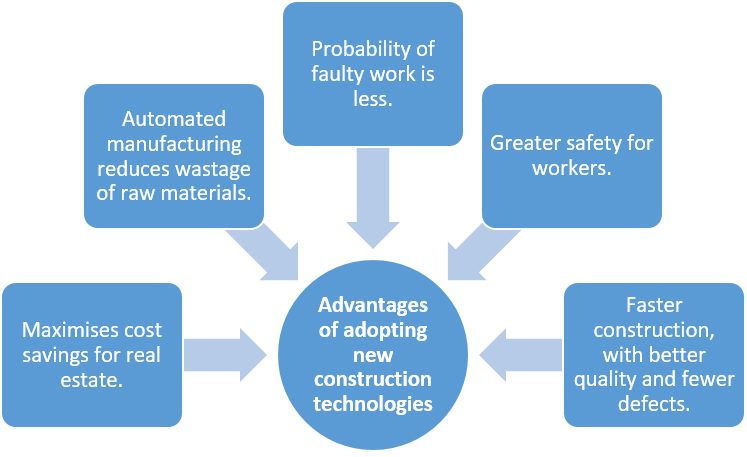News reports in the last two months were replete with stories depicting how real estate firms across India were wooing back migrant workers with more pay. As the country unlocks amid the COVID-19 pandemic, there is grave uncertainty over the availability of labour – on time and in the required numbers. The epidemic has also created severe disruptions in the supply chain of raw materials.
In this perspective, the government’s declaration of COVID-19 as a ‘force majeure‘ event, with an extension of project deadlines by six months under the RERA Act, is a welcome move. However, many feel this is too little, given the disruption that the pandemic has created across the country. Moreover, COVID-19 is likely to prompt some long-term structural changes in the labour market.
One clear indication is that many construction workers may not come back to the metros and tier-2 cities, in search of work. Secondly, a part of the labour force deployed in the construction industry is likely to move to the manufacturing sector. Manufacturing is considered more stable and safe and is set to witness growth, as it captures some of the investment share that is moving out of China. Indication of both these phenomena playing out in the future are already visible.
Why India needs to adopt new construction technologies
With labour in short supply, looming RERA deadlines and high customer activism, technological intervention seems to be the only viable solution for the real estate industry, to ensure timely completion of residential projects.
In a country like India, construction technology is critical to address labour shortage and also essential, to alleviate the severe housing shortage. India will need 25 million more affordable housing units by 2030 and with the current labour displacement, this is a mammoth task.
Technology is the only logical solution to the current situation. We have seen similar successful strategies implemented in China, Singapore and Dubai, and there is an opportunity to adopt a similar approach in India.

See also: Everything you need to know about Mivan construction technology
What is DfMA construction?
A cost-efficient and quality solution is DfMA (Design for Manufacturing and Assembly). Today, DfMA is being used across the manufacturing sector in India, to build cars, phones, electronics, etc. In the western world, the middle-east and Asia, DfMA in construction has seen widespread adoption and success and is a viable solution for India.
DfMA is a combination of two methodologies – design for manufacture and design for assembly. Most buildings are made up of standard components, such as walls, fittings, beams, columns and floors. However, rather than standardising these elements for optimisation, most are designed as one-off features. In DfMA, standardised components are designed and put together, to achieve intricate designs, much like Lego blocks. Standardising component design is critical, as it allows for the components to be assembly-line produced in automated, offsite factories. Factory production ensures quality and large-scale production.
In the 19th century, when cars were first built, it would take months to build a car. Today, it takes hours using factory production and robotics. DfMA, combined with offsite manufacturing, can have a similar impact on construction. DfMA is used by offsite construction companies globally, to build and deliver quality buildings, with speed and scale.
Ten-storeyed housing buildings are now being manufactured in months. China and Italy have built hospitals for COVID-19 patients in weeks, using this same principle. Implementing this proven process in the Indian housing sector, can be a solution to our crisis.
Let us consider an example. In a housing project, different components of the house, such as walls, fittings, beams, columns and floors, can be manufactured in the factory as per their specific designs, using high-end technologies like robotics and automation. Given the level of precision, these components may have zero defects. After its manufacture, these components can be transported to the project site, where it is assembled.
Advantages of DfMA construction
DfMA, combined with offsite manufacturing, can also maximise cost savings for real estate companies. Given the scale of housing demand in the affordable, semi-luxury and high-end segments, these technological interventions can prove to be game-changers.
As most of the manufacturing under DfMA is automated, the wastage of raw materials is reduced substantially. Similarly, the probability of faulty work, leading to alteration of design as seen in the case of onsite construction projects, is less when DfMA is adopted. The safety of workers is high, owing to the use of automation and robotics. In terms of quality, the construction will be better, with fewer defects and it will be more durable than regular projects.
Another striking feature of DfMA is that buildings are computer-modeled at the design stage, to test potential risks, which enable early action before factory production or on-site installation.
The adoption of this technology can reduce material costs by around 15%. Savings are also achieved from preventing any cost overruns due to project delays. Housing projects will be completed faster than conventional constructions. It will also help realty firms to plan and execute more projects in a given time, boosting their revenues and net profits.
Other technologies that can revolutionise the construction industry
Apart from DfMA, precast and 3D printing can also be adopted for faster completion of projects. While traditional precast technology has seen some level of adoption in India, offsite construction and 3D printing in construction are yet to gain pace, due to less availability of required machinery, leading to high costs.
India has set an ambitious target of providing ‘Housing for All by 2022’. Along with the PMAY (Pradhan Mantri Awas Yojana), the recent cabinet approval to construct Affordable Rental Housing Complexes (ARHCs) for migrant workers, will give a boost to affordable housing projects. This, coupled with rising demand for luxury and semi-luxury residential properties, can only be delivered on time, with the adoption of new technologies, failing which the real estate industry will lose a significant opportunity to transform and grow.
(The writer is country head, Katerra India)






